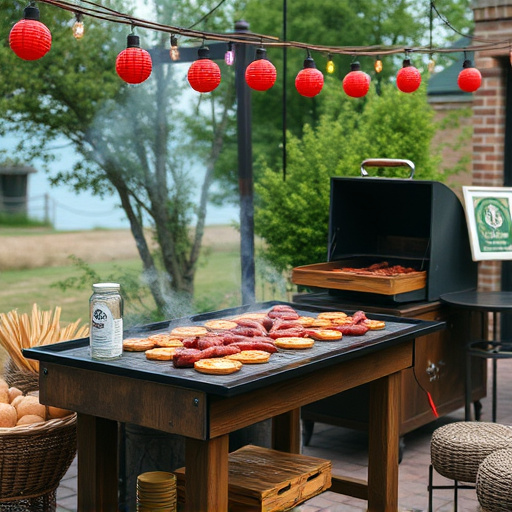Selecting a high-quality, fresh whole turkey (12-14 pounds serving 4-6) and pairing it with a fresh, balanced BBQ rub is key to crafting a perfect BBQ turkey recipe. Tailor spice levels and apply a generous coat of rub for crispy skin and moist meat. Master smoking techniques and side dish pairings for an exceptional BBQ experience. Store leftovers properly for up to 2 months or reheat in the oven at 350°F (175°C).
Discover the secrets to crafting a mouthwatering BBQ turkey feast with this classic rub guide. From selecting the perfect bird to mastering the art of spice combinations, each step ensures a delicious smoky flavor. Learn the technique for evenly applying the dry rub and explore effective smoking methods. Plus, find side dish suggestions and expert tips for storing and reheating leftovers. Elevate your BBQ game with this ultimate BBQ turkey recipe.
- Choosing the Perfect Turkey for Your BBQ Rub
- Measuring and Combining Spices for Flavor Balance
- The Art of Dry Rub Application for Even Cooking
- Smoking Techniques to Enhance the BBQ Turkey Flavor
- Pairing Side Dishes for a Complete Meal Experience
- Tips for Storing and Reheating Leftover BBQ Turkey
Choosing the Perfect Turkey for Your BBQ Rub
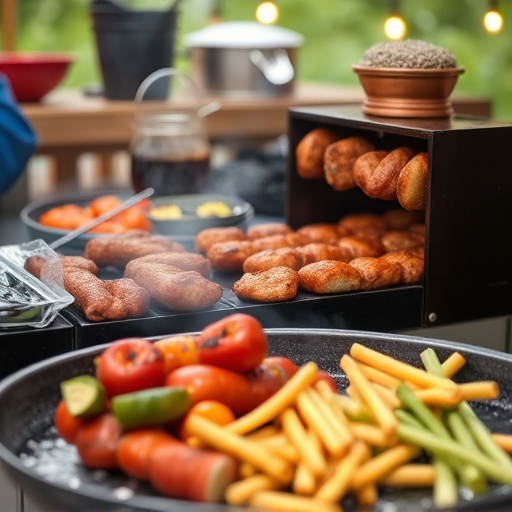
When it comes to crafting the ultimate BBQ rub for a delicious turkey, selecting the right bird is half the battle won. Opt for a high-quality, fresh whole turkey as your canvas for this flavorful seasoning blend. Look for a turkey with a good balance of meat and fat, ensuring even cooking and juicy results. A typical 12-14 pound turkey will work well for a group of four to six people. Consider choosing a free-range or organic bird for enhanced flavor and better welfare standards.
Remember that the quality of your ingredients significantly impacts the final dish. Choose a fresh, high-quality rub to maximize the flavor infusion during the slow cooking process. This classic BBQ turkey recipe is versatile, allowing you to adjust spice levels to suit your preference. Whether you prefer a subtle, smoky blend or a bold, spicy kick, selecting the perfect turkey and the right rub will ensure a mouthwatering BBQ experience.
Measuring and Combining Spices for Flavor Balance
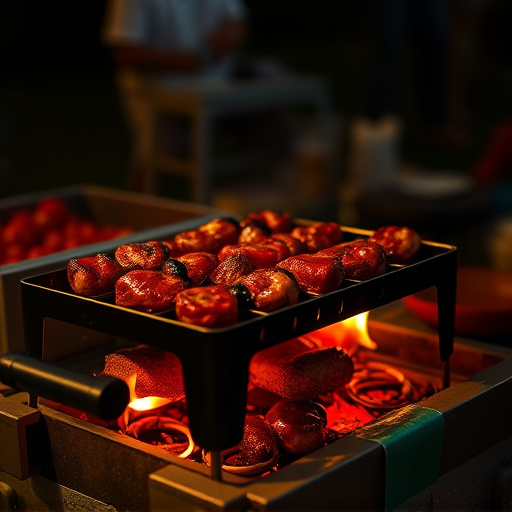
Achieving the perfect balance of flavors is key to an exceptional BBQ turkey recipe. When crafting your rub, measure each spice carefully to ensure a harmonious blend. Start with a base of salt and pepper for a robust foundation, adding subtle notes like garlic and paprika for depth. Balance these with more delicate spices such as cayenne or chili powder for heat, depending on your preferred level of kick.
Combine the spices in precise ratios to create a well-rounded profile that complements the turkey’s natural juices. Too much of one spice can overpower, while too little may leave you craving more. Experimenting with different combinations is part of the fun, but keeping a consistent ratio will ensure your rub performs beautifully every time, infusing your BBQ turkey with rich, complex flavors.
The Art of Dry Rub Application for Even Cooking
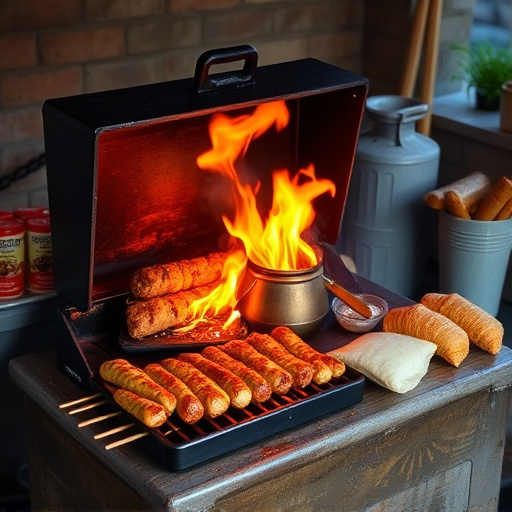
The art of dry rub application is key to achieving even and delicious flavors in your BBQ turkey recipe. Start by thoroughly drying the turkey’s skin before seasoning; this ensures better adhesion and prevents sogginess. Use a generous handful of rub, covering all visible meat surfaces—top, bottom, legs, and wings. For even distribution, gently rub the spice blend into the skin using your fingers or a brush. This technique creates a crispy exterior while locking in juices, resulting in a succulent turkey that’s as tasty as it is visually appealing.
Remember, patience is paramount during cooking. Avoid the temptation to flip or disturb the bird too often, allowing the rub to develop its rich flavor profile undisturbed. The longer the rub sits on the meat, the more intense the flavors will become, so plan accordingly for a truly mouthwatering BBQ turkey experience.
Smoking Techniques to Enhance the BBQ Turkey Flavor

Enhancing the flavor of your BBQ turkey goes beyond the rub itself; smoking techniques play a pivotal role in unlocking the full potential of this classic dish. For an unparalleled experience, consider using a combination of direct and indirect heat. Start by preheating your smoker to around 250°F (120°C), creating a gentle, consistent heat that allows for slow cooking and tender, juicy meat. Place the turkey on the grill, ensuring even exposure to the smoke, and let the magic unfold as the natural juices intermingle with the aromatic compounds from the wood chips or chunks.
Switching between direct and indirect heat can create a symphony of flavors. Direct heat sears the surface, locking in juices and adding a delicious charred crust. Indirect heat, on the other hand, ensures steady cooking without over-drying the turkey. By alternating these techniques, you’ll achieve a BBQ turkey recipe that’s not only flavorful but also exquisitely moist and tender—a true delight for any barbecue enthusiast.
Pairing Side Dishes for a Complete Meal Experience
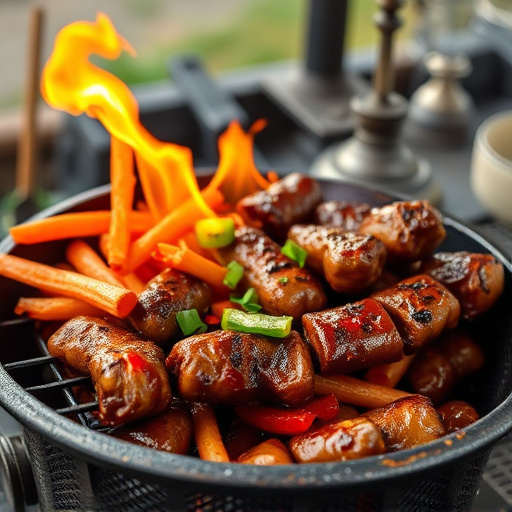
When crafting a complete barbecue experience, the key lies in balancing the main dish with complementary side dishes that enhance its flavors. For a classic BBQ turkey recipe, consider a side of creamy coleslaw to cut through the richness of the meat. The tangy dressing and crisp vegetables provide a refreshing contrast to the smoky, savory rub on your turkey. Another excellent pairing is a hearty baked bean dish, rich in brown sugar and bacon, which adds a sweet and salty element to each bite. These sides not only complete the meal but also ensure every flavor profile comes together harmoniously, making your BBQ gathering a true culinary delight.
Tips for Storing and Reheating Leftover BBQ Turkey
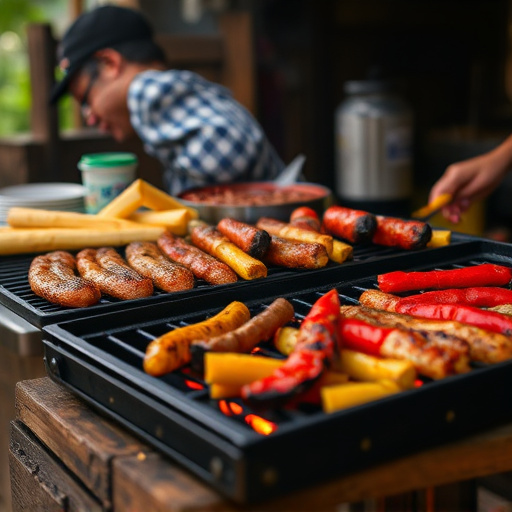
After savoring your classic barbecue rub for delicious turkey, you’ll likely have some leftovers. Storing them properly is key to maintaining flavor and quality. Place the leftover turkey in an airtight container or wrap it tightly in plastic wrap or aluminum foil. Store it in the refrigerator for up to 3-4 days. For longer storage, freeze the turkey in smaller portions for up to 2 months.
When ready to reheat, avoid the microwave as it can dry out the meat. Instead, use an oven or a slow cooker. Preheat your oven to 350°F (175°C) and place the turkey in a baking dish. Reheat for about 15-20 minutes per pound. Alternatively, you can shred the leftover turkey and use it in sandwiches, salads, or stir-fries for quick and easy meals.
